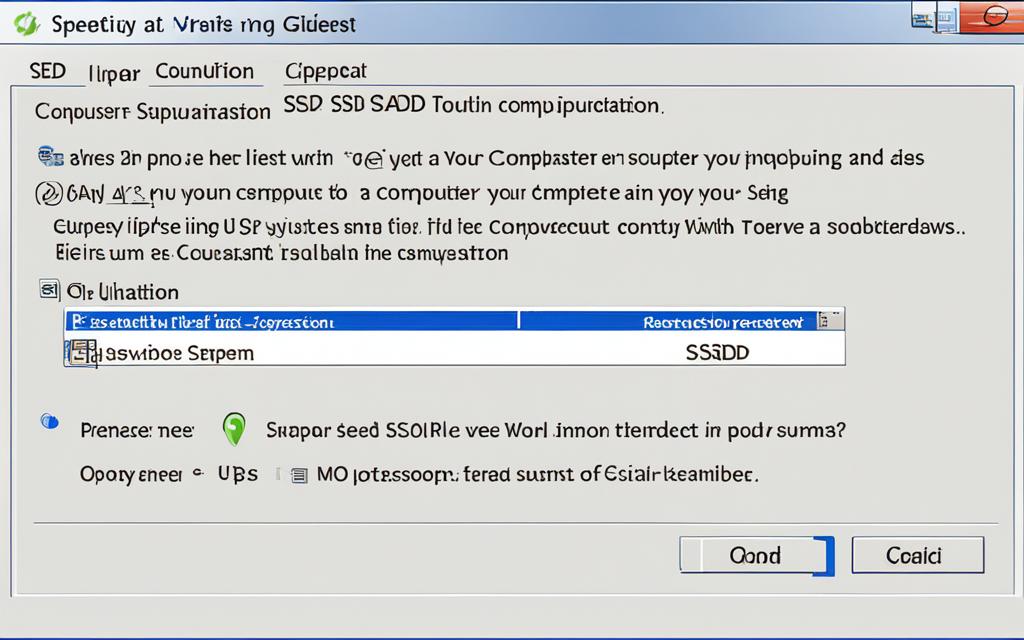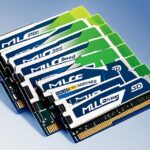Table of Contents
Upgrading to a solid-state drive (SSD) gives your computer a big performance boost. This SSD installation is more than just extra space. It changes how your operating system works, making everything faster and more responsive.
In this Windows installation guide, we’ll show you the key steps and things to consider for a smooth setup. You’ll see why an SSD makes your computer quicker and more reliable. Plus, your data stays safe. SSDs are much quicker at accessing data than old hard drives1. This means your computer will last longer, saving you money in the long run.
We’ll explain why putting your operating system on an SSD is a good move. For more detailed help, look at our upgrade guide. Here, you’ll find every step you need to follow.
Key Takeaways
- Switching to an SSD makes your computer faster and more reliable.
- It’s important to prepare well for the installation.
- Quick loading speeds improve how you work and play.
- Checking if your SSD fits with your operating system is key.
- Cloning tools can help move your operating system smoothly.
Why Choose an SSD for Your Operating System?
Choosing an SSD can change how you use your computer. The benefits of SSD are clear, especially for Windows installation. People now prefer SSDs over other types for better speed and efficiency. They are widely used in gadgets like laptops and servers.
Benefits of Installing Windows on an SSD
With an SSD, your computer starts much faster. Apps also open quickly2. They’re up to 10 times speedier than old HDDs. This leads to faster file access and quicker startup3. Everyone, including gamers, enjoys the speedy launches and better multitasking.
Performance Improvements
Switching to an SSD boosts SSD performance greatly. For example, SATA SSDs reach speeds of 550 MB/s. This speed is 10-15 times more than old HDDs4. Quick data access and shorter load times help users work or play more efficiently3.
Enhanced Reliability and Durability
SSDs are also more reliable than HDDs. They don’t have moving parts, so they’re safer from heat and impacts. This reliability of SSD means less chance of losing your data2. SSDs also use less power. This is great for devices like laptops where battery life is key4.
Understanding the Basics of Operating Systems
In computing, understanding what an OS is is key. An operating system (OS) is vital. It controls a computer’s hardware and software, allowing for user interaction. It also manages applications and delivers necessary services, playing a big role in daily tasks.
What is an Operating System?
The operating system acts as a bridge between you and the computer’s hardware. It runs programs and manages hardware, ensuring everything works well. The kernel helps software talk to hardware. System libraries let applications access functions.
The Role of an OS in Computer Functionality
An OS does more than just manage. It lets programs ask for services through an API, making things run smoothly and orderly. This lets computers multitask, prioritize, and carry out commands efficiently. In networks, it keeps operations reliable across different applications.
Common Operating Systems Available
Today, we have many operating systems, each designed for specific needs. Popular choices include:
- Windows: With a broad user base, it supports lots of applications and hardware.
- macOS: Preferred by creatives for its design and multimedia strengths.
- Linux: Great for developers, it’s versatile and open-source, ideal for servers.
Knowing about these systems helps pick the right one for your needs. It’s vital to check things like RAM and storage space. For example, Windows 11 asks for at least 4 GB of RAM and 64 GB of storage56.
| Operating System | Minimum RAM | Minimum Disk of Space |
|---|---|---|
| Windows 10 (32-bit) | 1 GB | 16 GB |
| Windows 10 (64-bit) | 2 GB | 20 GB |
| Windows 11 | 4 GB or more | 64 GB or larger |
Choosing the right OS can boost your productivity and happiness with your computer56.
Preparing Your System for SSD Installation
Before installing an SSD, knowing the SSD installation prerequisites is key. This ensures a smooth setup. You should get to know your system’s specifications. And find out what type of SSD it supports. This saves you both time and effort.
Essential Requirements Before Installation
First, make sure your computer can work with the SSD. Look for any issues with brackets and ports. Many computers need a SATA connection. Yet, some use NVMe for better speed. Ensure the SSD types and features are right for your motherboard. This will make your system run better and more efficiently.
Backing Up Your Data
Backing up your important data is a must. Unsafe data can be a big risk. You can use external drives or cloud storage as backup options. This protects your data when moving to the new SSD. You’ll feel secure knowing your data backup is reliable.
Choosing the Right SSD for Your Needs
Picking the right SSD depends on your needs. Think about how much storage you need and how much you can spend. Look at different SSD types and features. They come in sizes from 256GB to 2TB. Also, speed matters. Whether it’s SATA or NVMe, it will change how fast things load and run.
Choosing an SSD carefully prepares your system for setup. It leads to better performance and happiness. Knowing what to do beforehand makes the installation easy. Every choice you make helps upgrade your system successfully78.
How to Install an OS on a New SSD
Putting a new operating system on a new SSD can make your computer run faster and better. You can choose from several easy ways to do this. You might use a USB drive for installation or copy your old OS onto the new drive. Each method has its good points to think about.
Methods to Install Windows
One common way is to use the Windows installation media. This means making a USB drive ready with at least 8 GB of space. Set it as the first boot device in the BIOS settings. The Windows Media Creation Tool helps make the Windows 10 setup on your SSD9 go smoothly. Or, you could copy your existing OS to the SSD quickly without having to install it from scratch.
Using Windows Installation Media
Before installing from USB, back up your essential data to avoid losing it10. Once your media is ready, boot from the USB. Follow the steps to get Windows onto your new SSD. This method is liked because it feels familiar and makes sure your SSD performs well9.
Cloning an Existing Installation to Your SSD
Choosing to clone your OS? Use tools like EaseUS Partition Master for an easy move. Cloning keeps your current setting, making the shift to SSD smooth10 and9. After cloning, a reboot might be needed. Update your SSD’s firmware before moving everything for the best performance10.
For more on these methods, see detailed guides like this article. It gives step-by-step instructions on moving your OS to an SSD.
FAQ
What are the main benefits of installing Windows on an SSD?
Installing Windows on an SSD increases speed greatly, giving users fast data access and quick boot times. It makes applications start quicker and lets you do more at once. This change boosts your computer’s overall performance.
How does an SSD enhance computer performance compared to traditional hard drives?
SSDs make computers run faster because they access data quicker, with no moving parts. This means you get faster load times and more efficient work, especially with heavy tasks.
Why are SSDs considered more reliable than HDDs?
SSDs last longer and are more reliable than HDDs as they don’t have moving parts. This makes them less likely to get damaged, especially in laptops. They also use less power, which helps battery life.
What is the function of an operating system (OS)?
An operating system is a key program that manages all software on a computer. It connects you to the computer’s hardware, doing many essential jobs to keep the system running smoothly.
What are some common operating systems available today?
Today’s main operating systems are Windows, macOS, and Linux. Each one offers something different, catering to varied needs. This allows users to pick the best OS for their activities.
What prerequisites should I consider before installing an SSD?
Before adding an SSD, make sure it will work with your computer. Check the connection types and verify the SSD setup to ensure a smooth installation.
Why is it important to back up data before SSD installation?
It’s key to back up your data before putting in a new SSD to avoid losing important files. A secure backup means your data stays safe while you switch to an SSD.
How do I select the right SSD for my needs?
When picking an SSD, look at storage size, speed, and technology type, like SATA or NVMe. Matching these aspects with what you want to do helps you choose the best SSD within your budget.
What methods are available for installing Windows on an SSD?
You can install Windows on an SSD through clean installs or by cloning an existing one. Both ways have their benefits, and you can pick based on your migration needs.
How can I create installation media for Windows on an SSD?
To make a bootable USB for Windows, use tools and follow steps to prepare it. Download the Windows tool, get your SSD ready, and follow the prompts for a successful OS install.
What is the cloning process for migrating an OS to an SSD?
Cloning lets you move your OS to an SSD with software like EaseUS Partition Master. It’s quicker than a fresh install, moving all your settings and apps without hassle.
Source Links
- https://www.acronis.com/en-gb/blog/posts/how-to-move-os-to-another-drive/ – How To Move OS To Another Drive – Complete Guide & Software
- https://www.backblaze.com/blog/ssd-upgrade-guide/ – How to Upgrade Your Computer: Migrating from HDD to SDD
- https://www.intel.com/content/www/us/en/gaming/resources/ssd-improves-gaming-experience.html – How SSDs Impact Gaming – Intel
- https://www.kingston.com/en/blog/pc-performance/benefits-of-ssd – The 5 Benefits of SSDs over Hard Drives- Kingston Technology
- https://www.wps.com/blog/how-to-install-windows-1011-on-new-solid-state-drive-ssd-in-easy-steps/ – How to Install Windows 10/11 on New Solid State Drive(SSD)? (In Easy Steps) | WPS Office Blog
- https://www.lenovo.com/us/en/glossary/how-to-install-solid-state-hard-drive/ – How to Install a Solid-State Hard Drive
- https://www.easeus.com/partition-master/install-windows-10-on-ssd.html – How to Install Windows on SSD via 2 Easy Ways 🏆
- https://www.crucial.com/articles/about-ssd/how-to-install-solid-state-drive – How to Install a Solid State Drive into a PC
- https://www.diskpart.com/windows-10/install-windows-10-on-ssd-4348.html – How to Install Windows 10 on SSD Easily and Successfully
- https://mobiletrans.wondershare.com/how-to/transfer-os-to-ssd.html – How to Transfer OS to SSD in Windows: A Step-by-step Guide [2024]








